Dear Artist,
Yesterday, Jonathan Kwegyir Aggrey of Ghana wrote, “In my society there is no single word for ‘art.’ We have no distinction between ‘art’ and ‘craft.’ All are creative activities requiring skills and a sense of aesthetics. The aesthetic qualities of arts are not only determined by the language of art (i.e., rhythms, balance, shapes, lines, texture, etc.) but by the ethics or values of the people. Several art forms can be combined for a purpose. For example, music, sculpture, pottery, painting, textiles and dance may be used simultaneously. (A man may dance to a drum while wearing a mask and a special costume with his body partially painted — while carrying a ceremonial pot.) Art is a necessity, an integral force and a part of living — an essential role in everyday lives of Ghanaian communities. A particular work of art may be destroyed after use, no matter how beautiful or expensive it may be. We also have taboos: A blacksmith should not strike a person with his bare hands. A carver should not work when annoyed. Tools and materials need respect. The arts are not the privilege of a few selected people.”
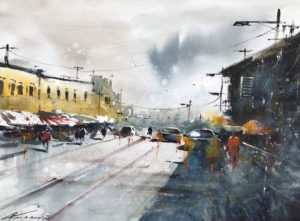
Business Day II, 2020
Watercolour on Arches 300 gram Watercolour Paper
22 × 29 9/10 inches
by Jonathan Kwegyir Aggrey (b.1984)
Thanks, Jonathan. I’ve never actually been hit by a blacksmith, but it’s handy to know that when I am, she’s liable to do it with her ball-peen hammer. What is evident from Jonathan’s information is just how universal and yet how particular are one’s attitudes about art. Both relief and insight are here. By contrast, in Western cultures it’s safe to say that art is often relegated to an elite activity — for the benefit of insiders. Broadening this base would mean inviting art into our human totality. In both cultures, art is a part of the way we understand things. In this sense we are brothers and sisters. We, the windows to our cultures, struggle daily with the same sorts of challenges — to understand, modify, and remake our worlds in our own way. Alone, but not always alone, we perform our dances.
Art need not be precious. Art’s a doing thing that sometimes gets commercialized — even in Ghana. Investment in, speculation on, and the private coveting of art are not prerequisite in all places. One might conclude that the introduction of commerce adds an odd spin to the act of art. But it’s still the ideas, tools, process and spirit that make art. For the people of this planet, art is as perennial as joy.
Best regards,
Robert
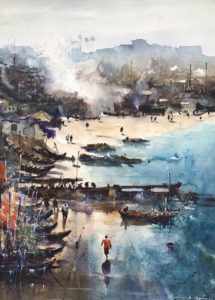
Cape Coast Fishing Bay, 2020
Watercolour on Arches 300 gram Watercolour Paper
29 9/10 × 22 inches
by Jonathan Kwegyir Aggrey
PS: “The visible universe is a storehouse of signs to which the imagination assigns a place and a relative value; it is a kind of nourishment that the imagination must digest and transform.” (Charles Baudelaire)
Esoterica: Yesterday I also received a note from Duane Dorshimer of Raleigh, N.C. He asked, “What is your artistic mission? To express? To communicate? To decorate? To idealize? To profit?” Thanks, Duane. Writing these twice-weekly letters has helped me to realize that there’s more than one reason to make art. In my case it’s everything you mentioned, but that stuff came later. When I was a kid I saw shamans who danced to a different drummer. I wanted to be like them, to have their power. I admired what those magicians did — and the skill and craft required to do it. It seemed to me to be a good thing, a good life.
This letter was originally published as “Comparing notes” on October 4, 2005.
Have you considered a Premium Artist Listing? With each letter, an artist is featured at the bottom of this page. The Premium Artist Listings are a means of connecting artist subscribers through their work. Proceeds from each listing contribute to the production of The Painter’s Keys.
“Everything that exists is the seed of that which will be.” (Marcus Aurelius)
Featured Workshop
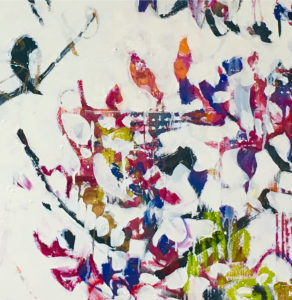 Join Ellie Harold for “Intuitive Painting: Permission to Paint Expressively,” designed especially for mature women artists of all skill levels who wish to explore this medium for soulful exploration. The retreat provides attractive accommodations (your own room!) along with lightly structured activities for centering, relaxation and low stress art-making. You’ll have plenty of free time to muse, paint, write and reflect while enjoying the colors, textures and flavors of San Miguel. This Retreat has the potential to transform not only your art but your life! You’ll return home with a specific art “care plan” to assure support for further creating. Details at www.EllieHarold.com.
Join Ellie Harold for “Intuitive Painting: Permission to Paint Expressively,” designed especially for mature women artists of all skill levels who wish to explore this medium for soulful exploration. The retreat provides attractive accommodations (your own room!) along with lightly structured activities for centering, relaxation and low stress art-making. You’ll have plenty of free time to muse, paint, write and reflect while enjoying the colors, textures and flavors of San Miguel. This Retreat has the potential to transform not only your art but your life! You’ll return home with a specific art “care plan” to assure support for further creating. Details at www.EllieHarold.com.
Featured Artist
I am inspired by the drama of light as it moves along forms, the rhythms and nuances of shapes, and the colours that change from subtle to vivid at any give moment. My expressive compositions, in oils, acrylics or watercolours, are a contemplative and heartfelt response to my experiences, representing the “visual music” I feel. Each brush-stroke is like a colour note or chord playing out the scene offering a connection with the viewer through dynamic movements and vibrant colour.

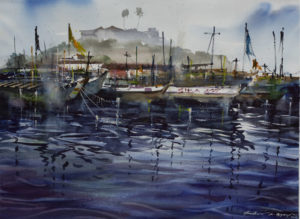
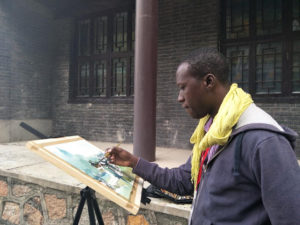




44 Comments
Beautiful. It is fascinating to me that “we” regard music and visual art as separate domains. I am a musician who switched my creativity switch to visual art. It feels quite normal to me.
What gorgeous, gorgeous paintings, jonathan! Thanks to you and Robert and Sara for sharing.
Different art forms inspire each other and can strive to be inclusive. Great article!
Thanks so very much.
I totally agree. “Art” (aka “fine art”) is only one very narrow category of creativity. Any work we do that we care deeply about, that makes us feel whole, that helps us get to our best self, that does the same for others when we share it ,(whether through sales, social media donations, collaboration, etc.) and makes the world a better place, is creative work.
In Western society, what has usually been relegated to the “craft” category and seen as somehow not “fine art” is usually women’s work — quilting, needlework, etc., all useful. Seems that art created by men without a practical purpose is more highly valued as “real art.”
Absolutely wonderful watercolors by Jonathan! I like his inclusion of all creative forms. It saddens me that many of our school systems do not see the value of art. It is the first thing that is taken away when cuts are made in the budget, like it is not important. When I was in high school, I majored in art for 4 years. I don’t believe the program exists today.
I remember reading Bette Edwards book, Drawing on the Right Side of the Brain. She saw what happened to students grades when art was taken out of the schools – they went down. When put back in, they went up. All the things we need to be productive humans are brought out when we create. Observation, decision making, problem solving, and the list goes on. The clothes we have on, the chair we sit in, the plates we eat off of all were designed by a creative person and when we use the gifts that God gave us and invite Him to create along with us, amazing, wonderful creations will be given to the world in all areas of the arts.
In my understanding “fine art” in the context of visual art is a term applied to non-functional art such as paintings and sculptures that are original rather than repetitive expressions and that imply a certain level of intellectual content and technical skill that separates them from decoration.
In my understanding, “craft” or “fine craft” is applied to works that may have most of the qualities of “fine art” but that are functional and produced repetitively, such as a potter making many identical (even if beautiful with an original design) bowls, a leatherworker making many of the same design belts or purses, a woodworker making cabinets, etc.
Sara, why were these 2020 artworks by Jonathan added or updated to your father’s 2005 letter? Your father never saw them, and I found them confusing and a bit misleading as they weren’t part of your father’s experience.
These are truly wonderful, exciting paintings. Loved them all
The fusion of art and daily life in Ghana as described by Jonathan Kwegyir Aggrey is truly fascinating. It highlights the universality of artistic expression while challenging Western notions of art as an elite activity. Art as a vital force in our lives is a perspective worth embracing globally.
Window & Door Repair Services in Port Orange FL
I admired the work that those magicians did, as well as the talent and craft that was required to perform it. To me, it appeared to be a positive thing, a positive way of life. Have the opportunity to relive the glory days of basketball or to experience the cutting-edge future of the sport today.
Basketball Legends 2020
I think “fine art” in visual art means non-functional art like paintings and sculptures that are original rather than repetitive and have intellectual content and technical proficiency that distinguishes them from adornment.
google baseball
Jonathan’s perspective on art as an integral part of life rather than a separate “elite” activity is so refreshing. It makes me wonder how Western art could evolve if we embraced this holistic view.
The idea that art can be temporary—destroyed after use regardless of beauty—challenges our obsession with permanence. Do you think this approach could help artists detach from ego?
Play Doodle Baseball at doodle-baseball.io! A hilarious casual game featuring fast-food characters hitting home runs. Enjoy classic baseball fun with simple controls. Fun for all ages!
Thank you. papa’s games
Cluster Rush fits under the larger trend of rage games or reaction-based platformers, such as Getting Over It, Geometry Dash, and Jump King. These games thrive on trial-and-error gameplay, in which failure is common and frequently amusing, and perseverance is the only way to succeed. Cluster Rush shares this DNA, offering an exciting, no-holds barred experience that rewards patience, timing, and skill.
Based on Jonathan Kwegyir Aggrey’s note, art in his Ghanaian society is not distinct from craft and is considered a necessary, integral part of everyday life, tied to the community’s values and ethics. Robert contrasts this view with Western culture, where art is often seen as an elite activity, but finds a universal connection in how both cultures use art to understand and reshape their worlds. He also reflects that art’s true value lies in the creative process—the ideas, tools, and spirit—rather than its commercialization or permanence. In response to a query about his own artistic mission, Robert states that his purpose has evolved to include expression and profit, but originated from a childhood desire to emulate the skill and “power” of artists he saw as shamans.
This is so thought-provoking! The title ‘Comparing notes’ is perfect for discussing how different cultures define creativity. Jonathan’s point about no distinction between ‘art’ and ‘craft’ in his society is incredibly interesting. It makes you reconsider our own Western definitions. Great share!!!
Quiz: Which Zootopia Character Are You? zootopia quiz
The Raise Animalsis Master the ultimate Roblox tower defense game. Learn strategies, discover all plants, and dominate the battlefield against brainrot invasions.
The Nano Banana 2is Master the ultimate Roblox tower defense game. Learn strategies, discover all plants, and dominate the battlefield against brainrot invasions.
The Run 3is Master the ultimate Roblox tower defense game. Learn strategies, discover all plants, and dominate the battlefield against brainrot invasions.
Play the classic Google Color Tiles and discover more colorful puzzle games. Match colors, eliminate tiles, and challenge yourself with endless fun!
An animated musical fantasy where K-pop meets supernatural adventure.
KPop Demon Hunters
Grow a Garden – The Ultimate Roblox Simulation Game
Welcome to Grow a Garden, the most popular Roblox simulation game! Plant seeds, nurture your crops, unlock adorable pets, and discover rare mutations as you build and expand your dream garden. Whether you love relaxing simulation games or crave a new tycoon adventure, Grow a Garden offers endless fun, surprises, and a vibrant community. Start your gardening journey now and see why millions of players are hooked!
Labubu Wallpaper
wow! PokeRogue is an exciting and strategic rogue-lite experience that redefines what fans expect from pokemon games.
Hot Pre-Sale! Tap to draw your Nano Banana Prompt and unlock random pets, crops, and more surprises!
Nano Banana Image Generator: Redefining AI Image Generation,Experience advanced context-aware image generation and editing. Input text, images, or both to create coherent, high-quality visuals tailored to your needs.
FLUX.1 Kontext is an advanced suite of generative models developed by Black Forest Labs, designed for context-aware image generation and editing. Unlike traditional models that rely solely on text prompts, FLUX.1 Kontext enables users to input both text and images, facilitating seamless extraction and modification of visual concepts to produce coherent and contextually relevant renderings.
I build a new game Crazy Cattle 3D Unblocked
AI Tools
hhh, I build a best AI Anime Generator
Whether you’re playing our classic version or themed variants like Halloween 2048, Christmas 2048, Taylor Swift 2048, or Trump 2048, the rules remain the same. In this 4×4 grid, your goal is to merge tiles with the same numbers to ultimately create the 2048 games.
A simple background tool with fullscreen support and quick switching,quick get the Black Screen.
Convert your Markdown Html, to clean, semantic HTML instantly. Free, fast, and no sign-up required.
Chang specifically designed for Dachshund Clothes,and prioritize using Handmade techniques and Premium Fabrics for every product.
In sled rider, every slope is a new challenge! Experience the thrill of racing against time and mastering tricky turns. With stunning visuals and engaging gameplay, you won’t want to put it down. Are you ready to take on the world as a Sled Rider?
Immerse yourself in a lively digital space where creativity takes the spotlight. From customizing avatars to designing personal spaces, every detail reflects your style. The magic of avatar world comes from its strong social elements, allowing players to interact, collaborate, and enjoy shared adventures. Whether participating in events, solving puzzles, or exploring vibrant areas, the game constantly offers something new. Its colorful design and open-ended gameplay create an inviting world perfect for players who enjoy imagination-driven experiences.
Greate! New Model is Now! Flux 2 Max AI AI Image Generator & Editor
Greate! You create comfort and presence in the ways.
[Flux 2 Free](https://flux2.free)
Greate! New Model is Now! pokepath game
Jonathan’s perspective on art as an integral, everyday “doing thing” that blends skill and aesthetics is wonderfully refreshing. It challenges the Western idea of art as an elite pursuit and highlights the universal human drive to create and understand our world. This emphasis on craft and purpose, from ceremonial pots to the strategic planning needed in games like Pokepath TD, really connects the dots between diverse forms of creative expression. It’s about the spirit of creation in all its forms, making life richer. Thanks for sharing!